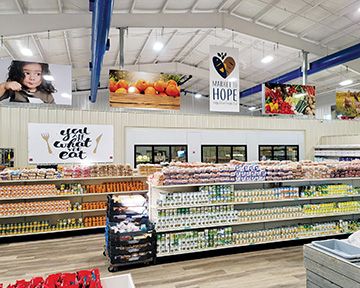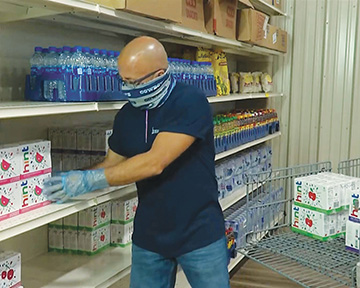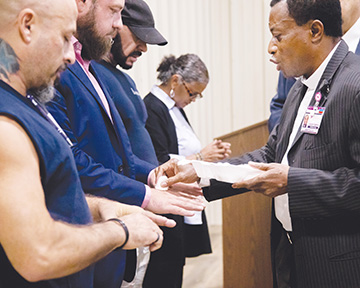Market to HOPE's supporters include CHRISTUS Health
By LISA EISENHAUER
Catholic Charities of Southeast Texas served nine families at its Market to HOPE in January 2020, the month the grocery-modeled food pantry opened. Over the next two months, as the closures caused by the COVID-19 pandemic pulled the financial rug out
from under many people, requests for assistance from the market grew.

So clients can easily assemble a basket with the components of a well-balanced diet, the shelves at the Market to HOPE food pantry in Beaumont, Texas, are color coded to match the MyPlate diet recommendations from the U.S. Department of Agriculture.
Clients can take as much fresh produce home as they'd like.
Christopher M. Robertson, director of Market to HOPE until this spring, said the number of people coming for groceries every month was in the thousands for the rest of the year.
The demand has eased as the economic impact of the pandemic has waned, yet it is still high. In a three-month period in late 2021, Robertson said Market to HOPE tallied 5,523 people making grocery pickups. "The need was so much bigger than we had anticipated,
so we keep Tuesday and Saturday curbside drive-thru for anybody who needs it," Robertson said.
The HOPE in the food pantry's name stands for Help Other People Eat, an urgency that is particularly sharp in and around Beaumont, where Catholic Charities of Southeast Texas is based.
Verified need
The extent of the need is one reason that the CHRISTUS Community Impact Fund and CHRISTUS Southeast Texas Health System gave Catholic Charities a $100,000 grant for Market to HOPE last year. In addressing food insecurity,
the fund was responding to community health needs assessments led by CHRISTUS Health's community benefit program to identify unmet health needs through surveys, focus groups and key stakeholder interviews.

Warehouse coordinator Jose Gutierrez stocks shelves at Market to HOPE. Catholic Charities of Southeast Texas opened the grocery-like food pantry in 2020.
Nadine Monforte, a manager of the community benefit program at CHRISTUS Health, said food insecurity was a top concern in the Southeast Texas community assessment. Survey responses showed 21.5% of the people in the communities the system serves in the
region don't always have enough food. The nonprofit network Feeding Texas reports that statewide 13% of households sometimes go hungry.
Monforte said Market to HOPE was one of five food programs that got a total of $450,000 in CHRISTUS Community Impact Fund grants last year. "We call them investments because they are focused on improving the health of our communities," she said.
To get the grants, Monforte said the operators have to show that their programs are sensitive to the culture and ethnicities of their clients. She said that sensitivity is reflected in many ways, such as the food a pantry stocks, how it distributes that
food and how it educates recipients on nutrition and food preparation.
"If the programs are not culturally responsive, potential clients may actually decline from enrolling or fully utilizing that support," Monforte said.
Maintaining clients' dignity
Chara Stewart Abrams is director of mission integration and community benefit at CHRISTUS Health. She and Monforte visited Market to HOPE in November when the grant was officially announced. She said
it was impressive to see the lengths that Catholic Charities was taking to respectfully welcome clients to the pantry and to guide them through an intake process that includes getting information about their financial means and health issues.
"Helping people have their dignity in the lowest points in their lives in these situations is, I think, one of the most important things we can do as human beings," Abrams said.
Robertson agreed. He said Market to HOPE is modeled on a grocery store so clients can have much the same food shopping experience as other consumers. Clients can sign up for a monthly food pickup at the pantry's drive-thru or for a time to come into the
pantry. Those who opt to come inside get to fill their own carts. While there are caps based on household size on the amounts of some items that clients get, clients can take home as much produce as they'd like.
The pantry's setup reflects its focus on nutrition. Shelves are color coded to match the MyPlate diet recommendations from the U.S. Department of Agriculture so clients can easily assemble a basket
with the components of a well-balanced diet. The volunteer staff are trained on food options to suggest to clients based on health concerns.
Dried beans and pigs' feet
The pantry stocks staples such as rice, bread and milk. Its other offerings are determined by what's available from suppliers and what's in demand by clients. Its clients come from communities that have
large African American and Hispanic populations, whose preferences drive the pantry's culturally appropriate offerings.

Fr. Leonard Ogbonna, manager of spiritual care for CHRISTUS Southeast Texas Health System, blesses the hands of Christopher M. Roberston, second from left, and other workers at an open house at Market to HOPE last fall. Robertson was director of the
pantry from its opening until this spring.
Robertson noted, for example, that he was told by one family that they and other Hispanics typically don't eat beans from a can. Since then, he said, the pantry has kept a full shelf of dried beans.
Another client thanked Robertson profusely for having mustard greens and pigs' feet in stock. "I've never eaten pigs' feet, but she could not have been more over the moon that she came in and got that," he recalled.
He said he scanned for pigs' feet on the lists of available items submitted by the pantry's suppliers.
After Market to HOPE clients make their selections, they wheel their carts to a checkout counter. "It's for inventory purposes but we check you out and we bag your stuff, put it in the grocery cart and you leave," Robertson said. "There's zero difference
from a regular grocery store except there's no cash that exchanges hands."
Beyond nourishment
Robertson added services after the market opened. When he wondered why some clients were getting little or no assistance from the federal Supplemental Nutrition Assistance Program, volunteers told him that many
of the people in the community had reading challenges and were probably filling out the necessary forms incorrectly.
He set up a monthly visit to the food pantry by a SNAP worker and invited clients to have their forms reviewed. The visits have meant more food assistance for many families. "Everyone I've spoken to so far has gotten an increase or an approval when they've
previously been denied," Robertson said.
The food pantry also is linking clients to Catholic Charities' asset building case management program. That program takes a comprehensive look at families' finances — including income, expenses and credit score — to create a sustainable financial
plan.
"Now the programs are kind of merged together, where people are receiving food but they're also learning how to manage the money that they're saving by not having to buy their own food, which in theory would be transitional," Robertson said. "You use
the market until you don't need the market anymore."
Probably no one is more impressed with the success of Market to HOPE in just two years than Robertson. He was working for Catholic Charities' disaster planning, emergency response and utility assistance efforts when he pitched the idea for the grocery-like
food pantry. He said he was eager to be a part of setting up the market; his supervisor decided to put him in charge.
"I had a great position. I loved my job," he said. "I had never planned on being the one who ran Market to HOPE, but it was the best decision she ever made for me."